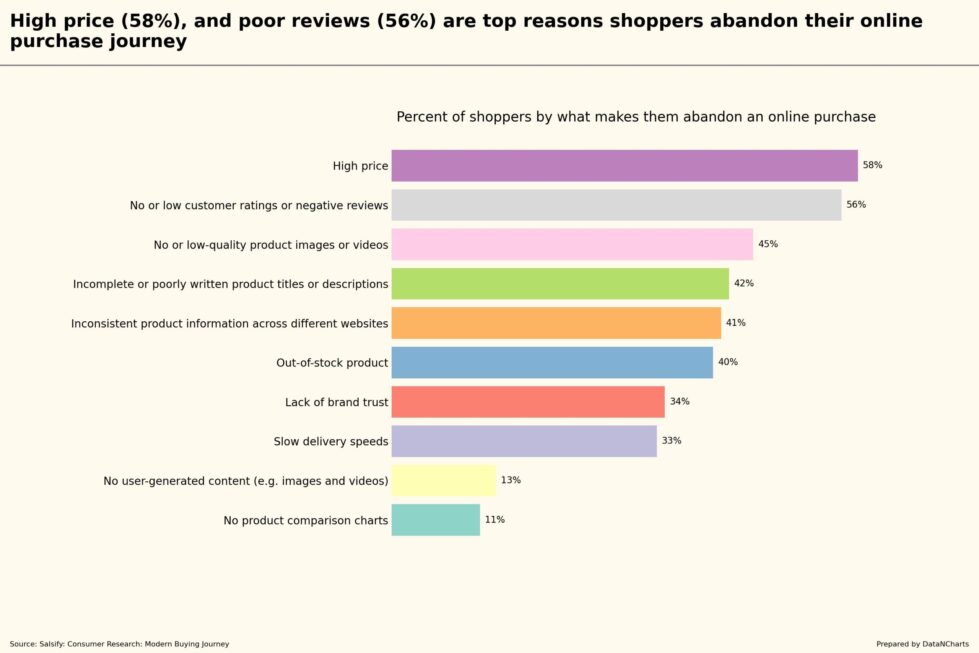Data Highlights
More than half (58%) abandon purchases due to high prices.
More than half (56%) leave when product ratings and reviews are low or missing.
Nearly half (45%) abandon carts when product images or videos are low-quality or missing.
More than four in ten leave due to inconsistent product details (41%) or incomplete descriptions (42%).
Four in ten (40%) drop out when products go out of stock.
One in three (34%) stop purchases due to lack of brand trust, while another third (33%) abandon due to slow delivery.
A negligible share (13%) leaves when user-generated content is missing, while an even smaller share (11%) stops due to lack of product comparison charts.
Scope
Cart abandonment remains a major challenge for e-commerce brands. Rising prices, inconsistent product details, and low-quality content push shoppers away. This brief explores key factors driving abandonment and provides clear insights to improve customer journey mapping, shopper experience design, and conversion rates.
High Prices Drive the Most Abandonment (58%)
More than half (58%) of shoppers abandon carts when prices feel too high. This suggests that pricing transparency and competitive discount strategies are critical. Shopper behavior research confirms that price-sensitive consumers compare multiple options before purchasing. Offering clear price breakdowns, discounts, and price-match guarantees can help reduce drop-offs.
Yet, price is not the only concern—shoppers also rely heavily on ratings.
Poor Ratings and Reviews Kill Purchase Confidence (56%)
More than half (56%) of shoppers abandon purchases due to missing or negative ratings. E-commerce consumer insights confirm that social proof plays a crucial role in purchase decisions. Retailers must actively encourage and display authentic reviews. Offering incentives for customer feedback and featuring recent reviews increase trust and engagement.
Even with strong reviews, weak visuals cause hesitation.
Poor Product Images and Descriptions Lower Conversions (45%, 42%)
Nearly half (45%) of shoppers leave when product images or videos are missing or low-quality. Similarly, four in ten (42%) abandon carts due to incomplete or poorly written descriptions. Shopper marketing strategies show that strong visuals and clear descriptions reduce purchase hesitation. Brands must prioritize high-resolution images, product demonstration videos, and clear, benefit-driven descriptions.
Content inconsistencies also cause friction.
Inconsistent or Incomplete Product Details Create Doubt (41%)
More than four in ten (41%) abandon carts when product information differs across platforms. A seamless omnichannel shopping experience ensures consistent product descriptions, specifications, and pricing across websites. Retailers aligning product details across all sales channels minimize consumer confusion and reduce abandonment rates.
Another major frustration for shoppers is product availability.
Stock Issues and Slow Delivery Cause Frustration (40%, 33%)
Four in ten (40%) shoppers abandon purchases when items are out of stock. Another third (33%) leave due to slow delivery times. Shopper behavior research highlights that brands improving inventory accuracy and offering faster fulfillment options retain more customers. Clear stock updates, estimated delivery times, and express shipping options help keep shoppers engaged.
Trust also plays a key role in abandonment decisions.
Brand Trust and Transparency Matter (34%)
One in three (34%) shoppers abandon carts due to lack of trust in the brand. Retail customer insights indicate that transparency about return policies, secure payment options, and clear brand messaging improve trust. Highlighting secure transactions, verified seller badges, and customer testimonials reassures hesitant buyers.
Some abandonment reasons are less significant but still notable.
Minor Factors: Missing Comparisons and User-Generated Content (13%, 11%)
A negligible share (13%) of shoppers abandon carts when user-generated content like customer images is missing. An even smaller share (11%) stops due to lack of product comparison charts. While these factors influence decisions, they are not primary drivers of abandonment.
Insights and Opportunities
Reducing cart abandonment requires brands to optimize pricing, product content, and consumer trust.
- Firstly, brands must ensure competitive and transparent pricing. Implementing real-time price adjustments, promotions, and installment payment options reduces sticker shock. Brands adopting these strategies can expect higher conversion rates, increased average order values, and lower cart abandonment rates. Key performance indicators (KPIs) include conversion rate improvements, cart abandonment reduction, and discount-driven purchase lift.
- Secondly, brands must enhance product content quality. High-quality images, detailed descriptions, and user-generated content significantly impact conversion rates. Brands prioritizing content improvements will see increased engagement, lower return rates, and higher purchase confidence. KPIs include engagement metrics, return rate reductions, and customer review growth.
- Finally, improving inventory accuracy and delivery speed minimizes shopper frustration. Brands optimizing inventory management and offering faster shipping options reduce lost sales and improve repeat purchase rates. KPIs include inventory accuracy rates, fulfillment time reductions, and repeat purchase frequency.
By focusing on these critical areas, retailers can significantly reduce cart abandonment, improve the shopper path to purchase, and drive higher conversions.
